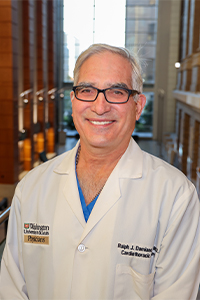
Ralph Damiano, MD
Ralph J. Damiano Jr., MD, is the Evarts A. Graham Professor of Surgery in the Division of Cardiothoracic Surgery at Washington University School of Medicine and Barnes-Jewish Hospital in St. Louis. Dr. Damiano was Chief of the Division from 2014 – 2025, and Cardiac Section Chief from 2000 – 2014. . He was co-chairman of the Heart & Vascular Center from 2000-2025.
Dr. Damiano has authored more than 470 scientific publications and given over 700 lectures and presentations around the nation and the world. His major contributions have been in the area of myocardial preservation, surgical electrophysiology, and minimally invasive cardiac surgery. He has been Associate Editor of the Journal of Thoracic and Cardiovascular Surgery of the Journal of the American College of Cardiology. He was Editor-in-Chief of the journal Innovations from 2008-2018. He has twice been a member of the Bioengineering, Technology and Surgical Sciences Study Section at the NIH. Dr. Damiano is past president of the Society of Clinical Surgery, the Cardiac Surgical Biology Club, and the International Society for Minimally Invasive Cardiothoracic Surgery. He was elected to the Board of Directors of the AATS from 2020-2024.
Dr. Damiano has been a pioneer in the area of minimally invasive cardiac surgery. His developmental work on robotically assisted microsurgery for coronary artery bypass grafting (CABG) earned him a Computer World Smithsonian Award in June of 1997. Dr. Damiano performed the first robotically assisted surgical procedure in North America, a CABG, in December 1998. He also has been a leader in the field of the surgical treatment of arrhythmias. His team at Washington University is world-renowned for its clinical and basic research on the surgical treatment of atrial fibrillation (AF). His group has been continuously funded by the NIH for over 30 years in this area. They have developed the gold-standard surgical procedure, the Cox-Maze IV operation, which has been adopted around the world, and is the only surgical procedure to have an FDA-approved indication to treat AF. His group has continued to evolve the procedure to be less-invasive, more effective, and more widely applicable to patients with this arrhythmia.